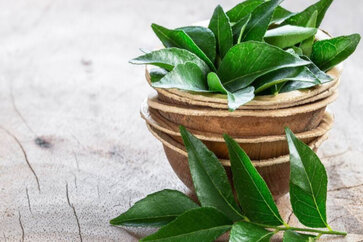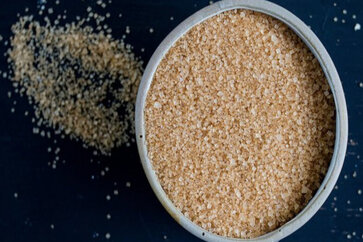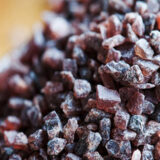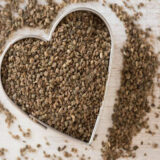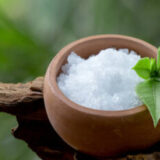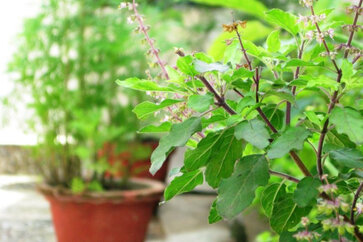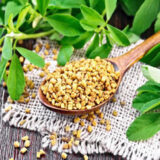Haritaki Churna | Benefits, Uses, Dosage And Side Effects
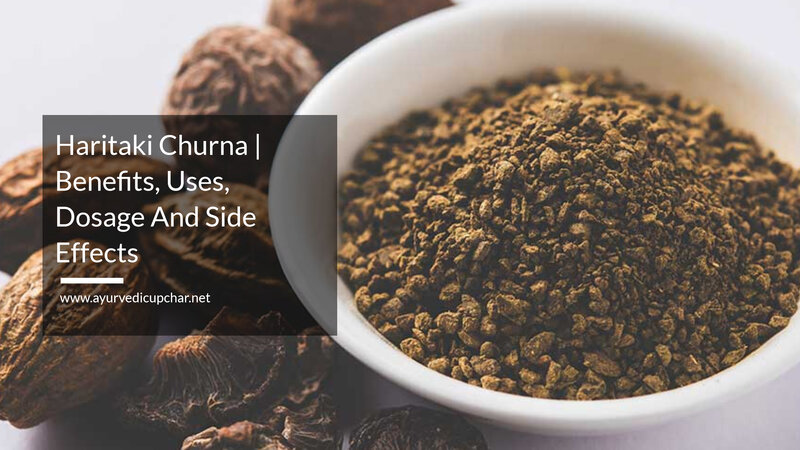 Haritaki Churna is popularly used as a therapeutic in Ayurveda; it is made from fruit commonly known as “Haritaki”, in the tribal of Tamil Nadu (India) it is known by the name of ‘Kadukkaai’.
Haritaki Churna is popularly used as a therapeutic in Ayurveda; it is made from fruit commonly known as “Haritaki”, in the tribal of Tamil Nadu (India) it is known by the name of ‘Kadukkaai’.
Haritaki Churna is generally used as a regular cleanser for the digestive system. It enhances the functioning of the spleen, liver, and colon; therefore, it is widely used as a digestive tonic.
Besides this, it has also been known to cure various ailments such as diarrhea, fever, gastroenteritis, cough, skin diseases, urinary tract infection, candidiasis, and wound infections.
The extract of Haritaki fruit is also used widely in many Ayurvedic preparations. Various studies indicated that the oil obtained from the seed of the Haritaki had particular substances that increased the movement of the gastrointestinal tract. It was found that the action was similar to that of castor oil.
Besides this, the extract obtained from Haritaki fruit was also reported to consist of a substance that has anti-fungal and antibacterial properties. Haritaki is also used in a mixture with two more herbs to prepare a formulation known as Triphala. Triphala is known to be a widely used medicine for Anti-aging activity besides for increasing immunity beyond the body.
Terminalia Chebula Indian Name
- Hindi- Harara, Harad
- Bengali – Haritaki
- Gujarati: Hardo
- Kannada: Harra, Karakkayi, Aalekayi
- Malayalam: Katukka
- Marathi: Hirda, Hirda-phula, Bala hirade
- Punjabi: Har, Halela, Hurh, Harrar
- Tamil: Katukkay
- Telugu: Karakkaya, Karitaki
- Assam- Silikha, Hilikha
- Nepal: Karka, Harro, Hir
- Kashmir: Halela
- Oriya: Haridra, Horitoli, Jonghihorida, Karedha, Harira
Classical Synonyms
- Haritaki
- Abhaya
- Pathya
- Kayastha
- Putana
- Haimavati
- Avyatha
- Putana
- Shiva
- Vayastha
- Rohini
How Does Haritaki Plant look like?
Terminalia Chebula or the so-called Haritaki Plant grows about 15-24 m high. Its leaves are ovate or elliptic with a pair of large glands at the top of the leafstalk.
Its flowers are yellowish-white, in terminal spikes. Its fruits are ovoid shape or egg-shaped with the color yellow to orange-brown sometimes shaded with red or black and hard when ripe sizes are about 3-5 cm long, 5 ribbed on drying.
Where are Haritaki Plant found in India?
Terminalia Chebula or so-called Haritaki Plants are commonly found throughout the northern regions of India. Besides this, it is generally found in temporal forests and areas where there is light rainfall and in area which is slightly moist.
It is found within the forest sloping upwards to an altitude of 1500 m in the Himalayas and the region of Assam, West Bengal, Orissa, Bihar, Maharashtra, Madhya Pradesh, Deccan, and South India.
Classical Ayurvedic Formulations of Haritaki
- Abhayarishta,
- Agastya Haritaki Rasayana,
- Chitraka Haritaki,
- Danti Haritaki,
- Dashamula Haritaki,
- Brahma Rasayana,
- Triphala Churna,
- Vyaghri Haritaki,
- Triphala Kvatha Churna,
- Pathyadi Kvatha Churna,
- Phalatrikadi Kvatha Churna,
- Abhaya Vati,
- Triphala Mandura,
- Shothari Mandura,
- Amavatari Rasa,
- Jalodarari Rasa,
- Nityananda Rasa.
Haritaki Churna Ayurvedic Preparations
- Triphala curna
- Abhayamodaka
- Abhayarista
- Pathyadi curna/vati/kvatha
- Vyaghn haritaki
- Gandharva haritaki
Ayurvedic Properties
- Rasa : Madhura, Amla, Katu, Tikta, Kashaya
- Guna: Laghu, Ruksha
- Virya: Ushna
- Vipaka: Madhura
- Prabhava: Tridoshahara
Action (karma) of Haritaki according to Ayurveda
- Deepaniya: Increases appetite
- Rasayana: Rejuvenative
- Brimhana: Nourishing
- Yogavahi: Catalyst enhancing the action of other herbs
- Pachana: Digestive
- Grahi: Absorbs fluids from the intestines
- Lekhaniya: Scrapes accumulation from the tissues and channels
- Chakshushya: Improves the eyesight
- Anuloma: Corrects the flow of vata downwards
- Stanyashodhana: Purifies breast milk
- Rechana: Purgative
- Vibandha hara: Alleviates constipation
- Medhya: Improves intellect
- Ayuvardhak: Increases longevity
- Arshoghna: Anti-haemorrhoidal
How To Use Haritaki Churna In All Seasons
There is a precise recommendation of the ‘Anupama’ (a material that works as a model for the herbs to be taken with) with which Haritaki must be combined, concerning the season.
- Varsa ritu (July- August): in this season it should be taken with rock salt.
- Sarad ritu (September-October): in this season it should be taken with sugar.
- Hemanta ritu (November- December): in this season it should be taken with sunthi.
- Sisira ritu (January-February): in this season it should be taken with pippali.
- Vasanta ritu (March-April): in this season it should be taken with honey.
- Grisma ritu (May-June): in this season it should be taken with jaggery.
Uses And Benefits Haritaki Churna
The ancient Charaka Samhita and Sushrusha Samhita have extensively described various therapeutic plants; T. chebula or the so-called Haritaki as well enjoys the principal place among remedial plants not only in India but also in other countries like Asia and Africa. Haritaki is extensively used in Ayurveda, Siddha, Unani, and homeopathic medicines in India.
- Haritaki is one of the top listed plants described in Ayurveda it is used for the treatment of an ailment such as bleeding piles, asthma, vomiting, gout, and sore throat.
- In Thai traditional Haritaki is used as a medicine to cure astringent, expectorant, and carminative.
- According to the Vagbhata text, it is an herb that is used for the therapy of ‘Vata-kapha’ diseases.
- It is one of the most important herbs that are used for the preparation of “Triphala.”. It is a remedy that is prepared from the three fruit plants called Terminalia Billerica, Terminalia chebula, and Emblica Officinalis. It is used as a laxative in chronic constipation, and food digestive problems (poor digestion and assimilation), a rejuvenator of the body, and detoxifying agent of the colon.
- There are certain studies that have shown that ‘Triphala’ stimulates appetite, and is beneficial in detoxification and healing cancer. Triphala is considered to be the most versatile of all herbal preparations and is also advised for candida infection and as a cardiotonic.
- The fruits of the Haritaki plant are used both internally as well as externally as a remedy; externally the paste of fruits is used for swelling, to speed up the healing, and to cleanse ulcers and wounds.
- Haritaki Churna is beneficial in erysipelas and other skin disorders as Haritaki helps to prevent the accumulation of pus in skin diseases.
- The oil of Haritaki is very beneficial in healing wounds, especially in burns besides oil, the paste of fruit is also used to apply in conjunctivitis for relief; it is beneficial due to its anti-inflammatory property.
- The gargles with a decoction made from Haritaki are very helpful in stomatitis and also for the problems of sore throat.
- There are many uses of Triphala such as it can be used externally for hair wash, for brushing the teeth in bleeding gums, or for pyorrhea. The decoction made from it can be used for washing non-healing wounds, chronic as well as ulcers.
- Haritaki Churna is used as a tooth powder to strengthen the gums. Besides this, an aqueous extract of haritaki is also used as a mouth rinse it is an antiquaries agent.
- Haritaki is an herb that is used to cure every body type for ‘Kapha diseases it is advised to take it with rock salt, for ‘pitta diseases with sugar, and for “vata” diseases with ghee.
- Haritaki Churna acts as a rejuvenator, and it can help to restore youth it can be used all around the year with varying supportive ingredients (dravyas) in different seasons.
- As per the reference of Vagbhata (the most influential classical writer of Ayurveda), if Haritaki Churna is fried in ghee and is regularly consumed with sufficient ghee in food, it promotes longevity and boosts energy.
- There are many common ailments that can be treated with Haritaki Churna such as tumors, gastrointestinal, enlargement of the liver, ascites, piles, worms, colitis, and spleen.
- Besides the uses of haritaki fruit, the Bark of Haritaki also has a medicinal value, if chewed after a meal it can improve digestion. The variety of ‘Bala haritaki’ is very beneficial in treating hemorrhoids and in cleaning the bowels.
- Haridra or so-called haritaki is an important ingredient of Triphala powder and is a well-known addition to diabetes. An ailment such as Bronchospasm can be effective with the combination of haritaki and bibhitaka powders with honey. In abdominal pain due to flatulence, it is given with jaggery and ghee.
- A popular ayurvedic remedy made with a combination of Haritaki Churna, sunthi, musta, and jaggery is an effective cure for diarrhea, dysentery, flatulence, etc.
- An ayurvedic formulation made from Haritaki known as “Siddha ghrta” is beneficial in chronic fever. A decoction of Haritaki or Triphala is also helpful to a person having hepatitis it should be taken in the combination with honey.
- Consuming Haritaki Churna with honey and ghee is an also effective remedy for anemia, if you are looking forward to solving problems of obesity, its decoction with honey is helpful as it reduces excessive body fats.
Haritaki if used regularly can improve memory due to beneficial effects on the nerves of the brain; besides this, it is also helpful in urinary stones and dysuria.
Precautions: Haritaki Churna should be used with Precautions especially by slim people, in fasting, in serious weakness, the person having mental depression, pitta conditions, and during pregnancy.


